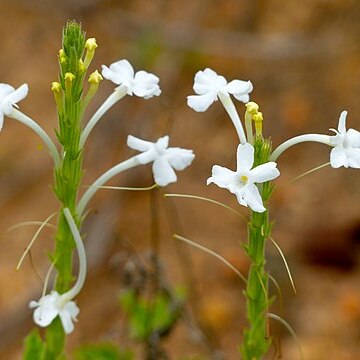Calyx erect, 8.8–12.4 × 1.4–1.6 mm, minutely appressed puberulous within towards the apex; teeth 0.2–1.3 mm long, subequal or unequal, subulate; fruiting calyx somewhat wider (2–3 mm in diameter), gibbous at base, more conspicuously costate and plicate at the apex, stramineous.
Mericarps separating when ripe, 4–6.5 × 0.9 mm, subcylindric, somewhat flattened at the commissural face, the back longitudinally ridged or striate below and reticulate above, more distinctly so on the upper ¼, at first stramineous, finally black, with basal pit.
Perennial herb 15–45 cm high, with a slender woody taproot; indumentum (except on corolla) puberulous, densest on the inflorescence, of patent gland-tipped short hyaline bristles, sometimes with few to numerous scattered eglandular soft setae interspersed.
Corolla creamy-white, with a slender tube abruptly expanded into a flat limb; tube 2–2.5(3) cm long, usually curved; lobes 4–4.5 mm long and wide, oblong or obovate, obtuse or emarginate at the apex, undulate or crisped at the margins.
Spikes terminal, straight, slender, 4–30 cm long, many-flowered, with the calyces appressed to the inflorescence axis; peduncle up to 2 cm long; bracts 4–6 × 1–2 mm, acute, ciliate; bracteoles absent.
Style up to 2.5 cm long after anthesis, often persisting for a short time as an exerted slender thread from the calyx tube.
Filaments 1.3–1.5 mm long in the upper pair of stamens, 0.7–1 mm long in the lower pair; anthers c. 0.8 × 0.5 mm, ovate.
Stems 1–several, decumbent to erect, simple or branched, leafy.
Ovary 2.2 × 0.5 mm, narrow-oblong or cylindric.

